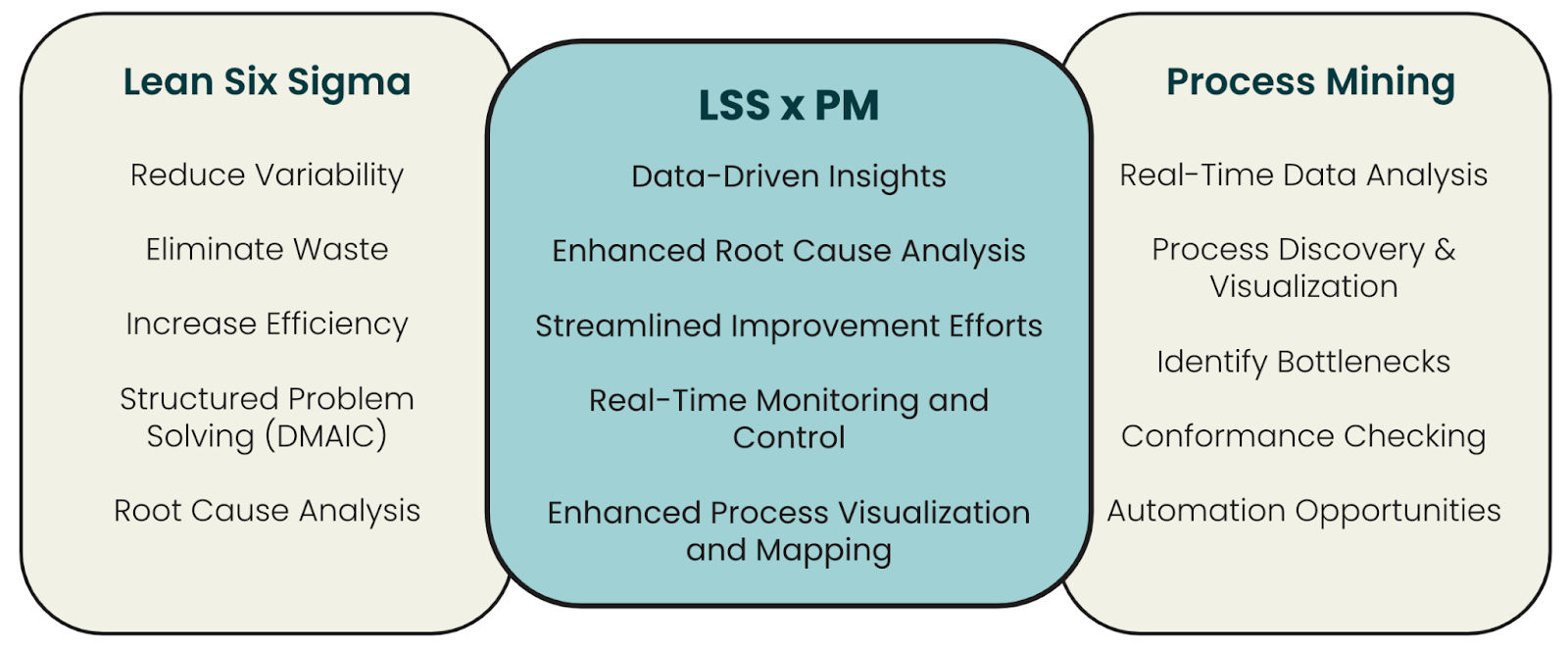The Synergy Between Lean Six Sigma and Process Mining
Joonas Maisala
Joonas is a Business Development & Digital Process Specialist who enjoys applying his deep technical know-how in sales. Joonas graduated from the University of Helsinki, where he studied Computer Science. He is currently completing his Master's Degree in Business Analytics at Aalto University.
In today's competitive business environment striving for efficiency is on everyone's agenda, whether it is on a personal level or at a company level. When focusing on company operations, seeking ways to streamline operations & processes, reduce waste and enhance overall efficiency is key.
The tried and true Lean and Six Sigma methodologies have been the cornerstone of operational excellence for decades. Meanwhile, Process Mining, a long-standing topic of research and a relatively new topic in business, is now gaining a lot of attention—and for a good reason (more on that soon). But what happens when these two powerful methodologies are combined?
Lean Six Sigma
Starting from Lean Six Sigma (LSS), which itself is a combination of two methodologies: Lean which focuses on streamlining processes and reducing waste, and Six Sigma which focuses on reducing variation and improving quality. LSS has been the go-to solution for structured problem-solving because of its wide applicability, robustness and data-driven approach.
However, being decades old its DMAIC (Define - Measure - Analyze - Improve - Control) problem-solving system could, in some opinions, be enhanced by incorporating real-time data analytics and machine learning to meet the data-driven needs of modern business demands. This is where Process Mining comes in.
Process Mining
Process Mining (PM) is an analytical discipline for discovering, monitoring, and improving real processes. It extracts knowledge from transactional data (event logs) readily available in today’s IT systems, such as ERP and CRM systems. Using advanced algorithms, AI/ML and data visualisation techniques, Process Mining provides real-time insights into how the process actually works, possible bottlenecks, deviations, and opportunities for improvement. This technology leverages data from IT systems to create a detailed map of complex processes, allowing for a more precise and objective analysis than traditional statistical and manual methods.
To understand how Process Mining works in practice, take a look at a previous article What is Process Mining?
Based on our experience, many companies utilising Process Mining struggle to extract tangible business value from it. Too often, they find themselves developing the tool but not fully capitalising on it. This is where the synergy can make a significant difference by ensuring that PM not only becomes “another tool” but serves the business by driving value through well-structured process improvements.
The Synergy
Combining Lean Six Sigma with Process Mining creates a powerful synergy that enhances the effectiveness of both methodologies. We do not see them as competing, but as complementary forces. By integrating these, businesses can achieve a deeper, reality-based and data-driven understanding of their processes, leading to more precise improvements and sustained operational excellence.
Here are a few ideas and examples of how we have combined Lean Six Sigma with Process Mining to improve processes:
Data-Driven Insights
Process Mining provides a detailed and real-time view of the process, which complements the Define and Measure phases of the DMAIC cycle. By not relying on anecdotal evidence and manual observations, PM utilises the actual event logs from IT systems to uncover how processes operate in reality. This approach enables a data-driven and accurate identification of inefficiencies and areas for improvement.
Example: Process Mining in the Define phase can help identify the scope and boundaries of a process by visualising the entire workflow, making it easier to pinpoint where to focus improvement efforts. It also helps identify and prioritise improvement projects by revealing the key areas that need the most attention.
Enhanced Root Cause Analysis
In the Analyze phase, PM can significantly enhance root cause analysis by identifying patterns and correlations in the data, which might be missed utilising only the more traditional analysis methods such as Exploratory Data Analysis (EDA) and Confirmatory Data Analysis (CDA). This helps LSS practitioners to find new improvement hypotheses faster and confirm them using data.
Example: If a customer service process has a high rate of unresolved tickets, Process Mining can identify specific stages where tickets are getting stuck. Pinpointing the root cause to inadequate resource allocation, procedural bottlenecks, or insufficient training - for example.
Streamlined Improvement Efforts
The insights gained from Process Mining allow for more targeted and effective improvements during the Improve phase. Many Process Mining tools can simulate changes and predict their impacts on the whole process. This should help teams prioritise actions that have the greatest positive effect on the process performance.
Example: Before implementing any actual changes, businesses can use Process Mining to model different scenarios and choose the one that optimises throughput and minimises waste.
Real-Time Monitoring and Control
A powerful advantage of integrating Process Mining with Lean Six Sigma is in the Control phase. Process Mining can be thought of as a measurement system for continuous monitoring of processes, enabling real-time statistical process control (SPC) for selected control variables. This proactive approach ensures that any issues are quickly identified and addressed and that the positive gains from LSS initiatives are captured and sustained.
Example: After process improvements are made, Process Mining can be utilised to continuously monitor the key performance indicators (KPIs) to ensure that the process remains stable and improvements are sustained over time.
Few Practical Steps to Integrate Lean Six Sigma and Process Mining
Based on our work with multiple organisations, these practical steps effectively leverage the synergy between Lean Six Sigma and Process Mining:
Assess Data Readiness: Ensure your organisation has access to the necessary event logs and data sources. Conversely, Process Mining is a powerful tool for recognising what new data organisations need and what master data should be improved.
Select Appropriate Tools: Choose PM tools that fit your organisations needs and integrate seamlessly with your existing systems and support your LSS initiatives. Popular Process Mining tools include Celonis, QPR, and Microsoft Power Automate Process Mining (formerly Minit).
Pilot Projects: As with anything new and shiny, it is a good practice to start with a pilot project to demonstrate the value of combining these methodologies. For example, a Green Belt project is a great place to start.
Train your Teams: Provide training for your teams on both Lean Six Sigma and Process Mining.
Conclusion
This synergy offers a powerful approach to achieving operational excellence. Combining the battle-hardened, structured problem-solving framework of LSS with modern tools such as Process Mining caters to the needs of the data-driven modern business world. Businesses can gain a deeper real-time understanding of their processes, implement more effective improvements, and better sustain these gains over the long term.
If you want to explore the synergy between Lean Six Sigma and Process Mining in your organisation, let’s discuss it further!




